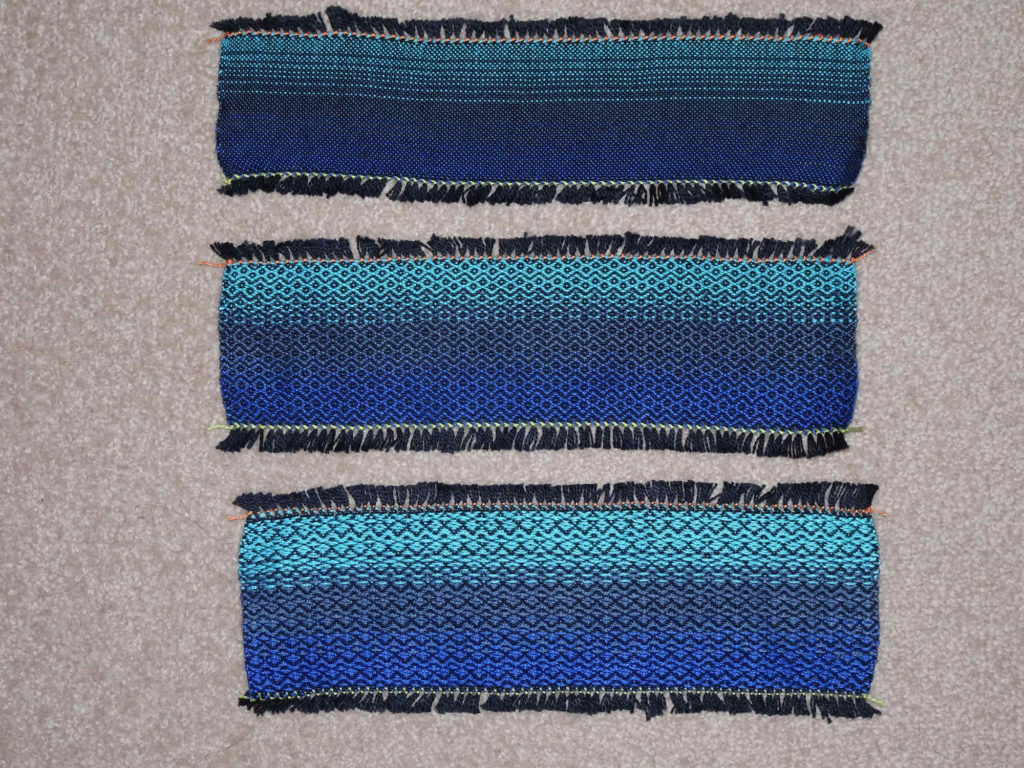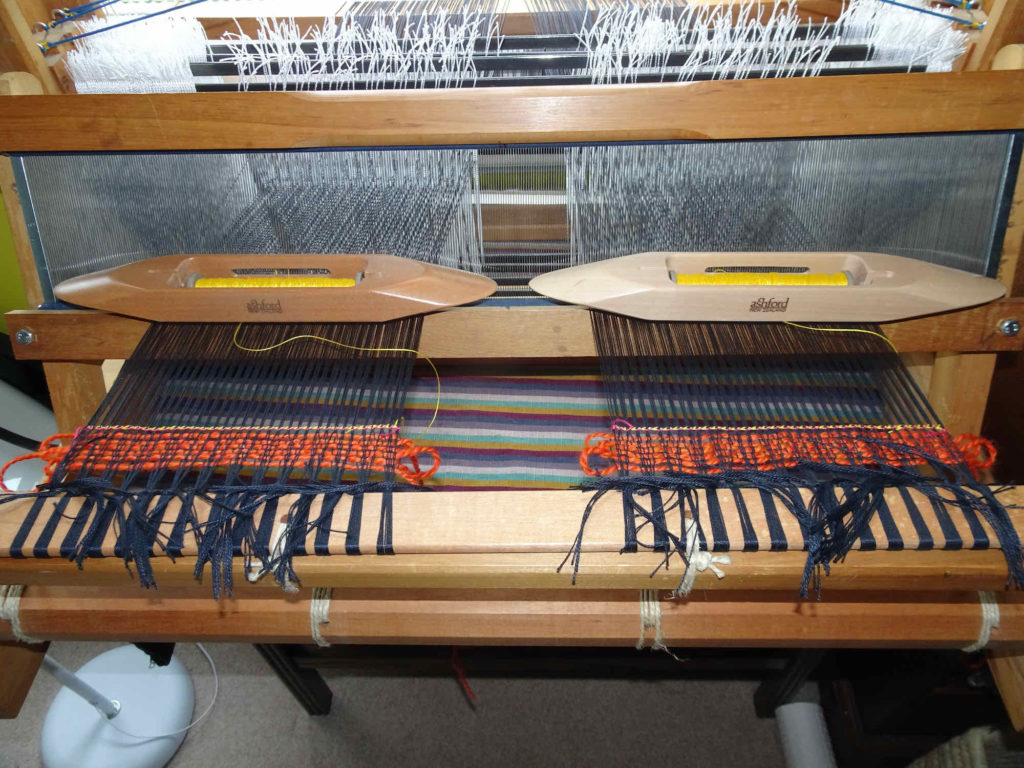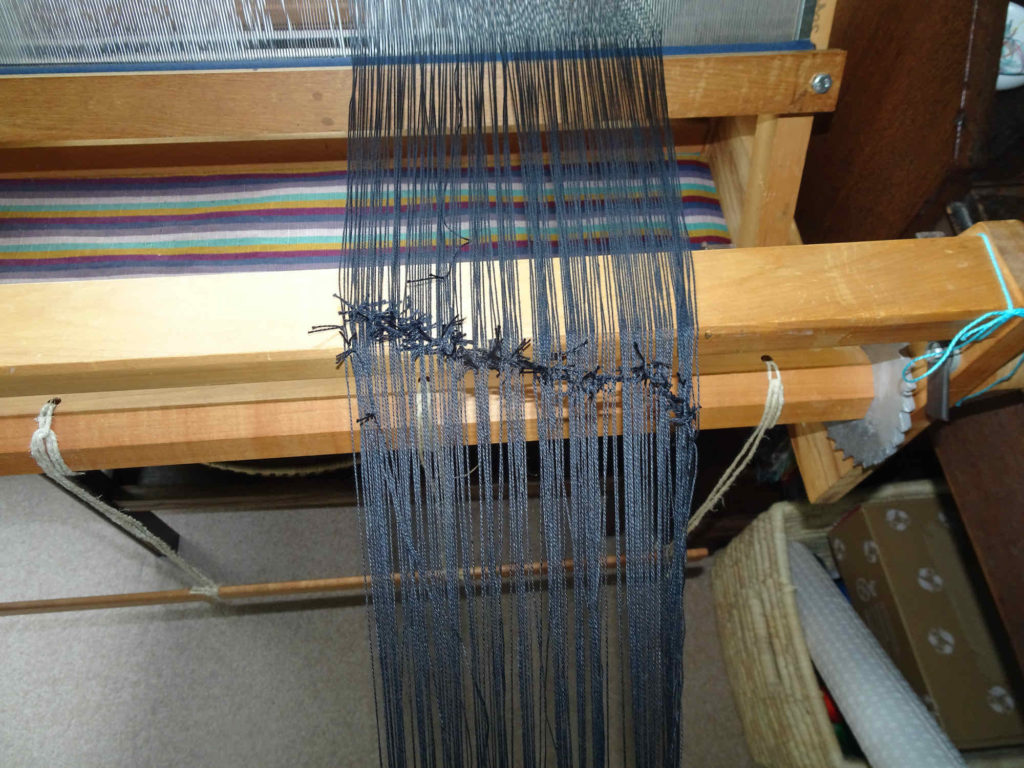After looking at the finished pieces so far from Warp 17 (pieces 1-3), I decided that while the fabric was lovely, I wanted to see what it would be like at a lower sett. I had chosen 24epi as the sett for this warp because it was the epi given for a gradient woven cowl in an online class by Tien Chiu that I was participating in. But for me, this fabric has less drape than I would like for a cowl. But first, I wanted to weave some samples at 24epi to compare to those of a lower sett. I have found the samples of 5/2 cotton at various setts to be very useful when planning a project, and would like similar pieces in 10/2 cotton.
I tied the warp back on to the front apron rod at 24epi and wove 6-7cm samples of plainweave (13, 24), 2/2 twill and 1/3 twill (both Wall of Troy – 1234321234). All 3 samples were hemstitched at both ends.
These samples were woven in a linear gradient of scuba blue – denim – dazzling blue
A:1B
3A:1B
2A:1B
1A:2B
1A:3B
1A:B
The gradients in pieces 1-3 had an extra 1A:1B in the centre. I decided that I prefer the gradient without these 2 picks.
After removing these from the loom, I hand washed them in warm water, trimmed loose ends and pressed with a hot iron.
The pieces were measured before and after washing to determine shrinkage:
Plain weave – before 6cm, after 6cm
2/2 twill – before 7cm, after 6.5cm
1/3 twill – before 7.5cm, after 7-7.25cm

24 epi samples – plainweave, 2/2 twill, 1/3 twill
I re-sleyed the reed at 20epi (a 16dpi reed, so 1,1,1,2 ends per dent). 20epi means that the fabric will be wider than at 24epi. 24epi resulted in a 30cm width on the loom, 20epi would mean 35.5cm width. I decided that I would rather have 2 pieces of narrower fabric, so I split the warp into 2 pieces of 140 ends each with a width of 17.75cm on the loom. I removed the 2 centre threads from their heddles so that I could have a floating selvedge on the “new” fabric edges. I allowed for a 12cm gap between pieces so that I could manipulate the shuttles between the pieces when weaving the 2 sides in parallel. The 2 warps were tied to the front apron rod and headers woven.

2 narrow warps woven in parallel
I wove as for the previous samples – plainweave (13, 24), 2/2 twill and 1/3 twill (both Wall of Troy – 1234321234). All 3 samples were hemstitched at both ends.
These samples were woven in a linear gradient of freesia (yellow) – celosia orange – chilli pepper (red)
A:1B
3A:1B
2A:1B
1A:2B
1A:3B
1A:B
I wove 2 plainweave samples side-by-side and then the 2 twill samples side-by-side. When weaving the twills, I changed shed as required for each piece. It was very possible to do this, although on the plainweave pieces I did introduce a couple of accidental floats due to the shuttle picking up a few of the bottom warp threads.
After removing these samples from the loom, I hand washed them in warm water, trimmed loose ends and pressed with a hot iron.
The pieces were measured before and after washing to determine shrinkage:
Plain weave – before9cm, after 8.5cm
2/2 twill – before 9.5cm, after 9cm
1/3 twill – before 10cm, after 9cm

20 epi samples – plainweave, 2/2 twill, 1/3 twill
These samples showed me that it is possible to weave 2 narrow warps side-by-side. I also have some great samples for future reference.
For the rest of this warp, I will stay with 20epi. I want to use this fabric for hair bandanas and think that it will make a nicer finished product than the 24epi fabric. Also, I quite like narrower width for the hair bandanas.
However, I don’t want to keep weaving 2 pieces in parallel. So I tied one warp onto the front apron rod in a single bundle and wound the entire warp onto the front beam while making a chain of the 2nd warp. Youngest son helped with this process – he wound while I chained. Once the entire warp was on the front beam, I cut the chained half from the warp rod and wound the remaining half back onto the back roller. I then tied each of the 140 of the chained warp ends to those still on the loom and wound the chained warp onto the loom. There were no tangling issues. The warp ends were tied to the front apron rod. I now have a warp of about 6m to work with and am ready to begin weaving again.

Two warps soon to be one 
Two warps knotted together 
All ready to weave again